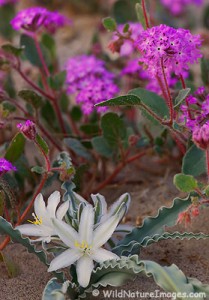 I’ve just returned from 2 weeks of camping, climbing and exploring in the Southern California Deserts. My climbing partner and I were blessed with a phenomenal wildflower show. From the desert lily and sand verbena (pictured on left) to the magenta fivespot, many rare flowers graced our hikes and climbs. Flowers thriving in the brutal environment of the Mohave desert, give a drought conscious gardener hope. Scrambling up Hellhole canyon in Anza Borego State Park, we saw hundreds of chuparosa shrubs and thousands of poppies and monkey flowers, as we ascended 1000ft into a treacherous canyon to a hidden oasis.
I’ve just returned from 2 weeks of camping, climbing and exploring in the Southern California Deserts. My climbing partner and I were blessed with a phenomenal wildflower show. From the desert lily and sand verbena (pictured on left) to the magenta fivespot, many rare flowers graced our hikes and climbs. Flowers thriving in the brutal environment of the Mohave desert, give a drought conscious gardener hope. Scrambling up Hellhole canyon in Anza Borego State Park, we saw hundreds of chuparosa shrubs and thousands of poppies and monkey flowers, as we ascended 1000ft into a treacherous canyon to a hidden oasis.
I spent this last weekend mushroom and wildflower hunting in Salt Point State Park. In stark contrast to the desert, the coastal landscape is lush and full of pacific coast iris (pictured top right), orchids and trillium. Despite getting wet during the storm Saturday night, it was a terrific trip.
